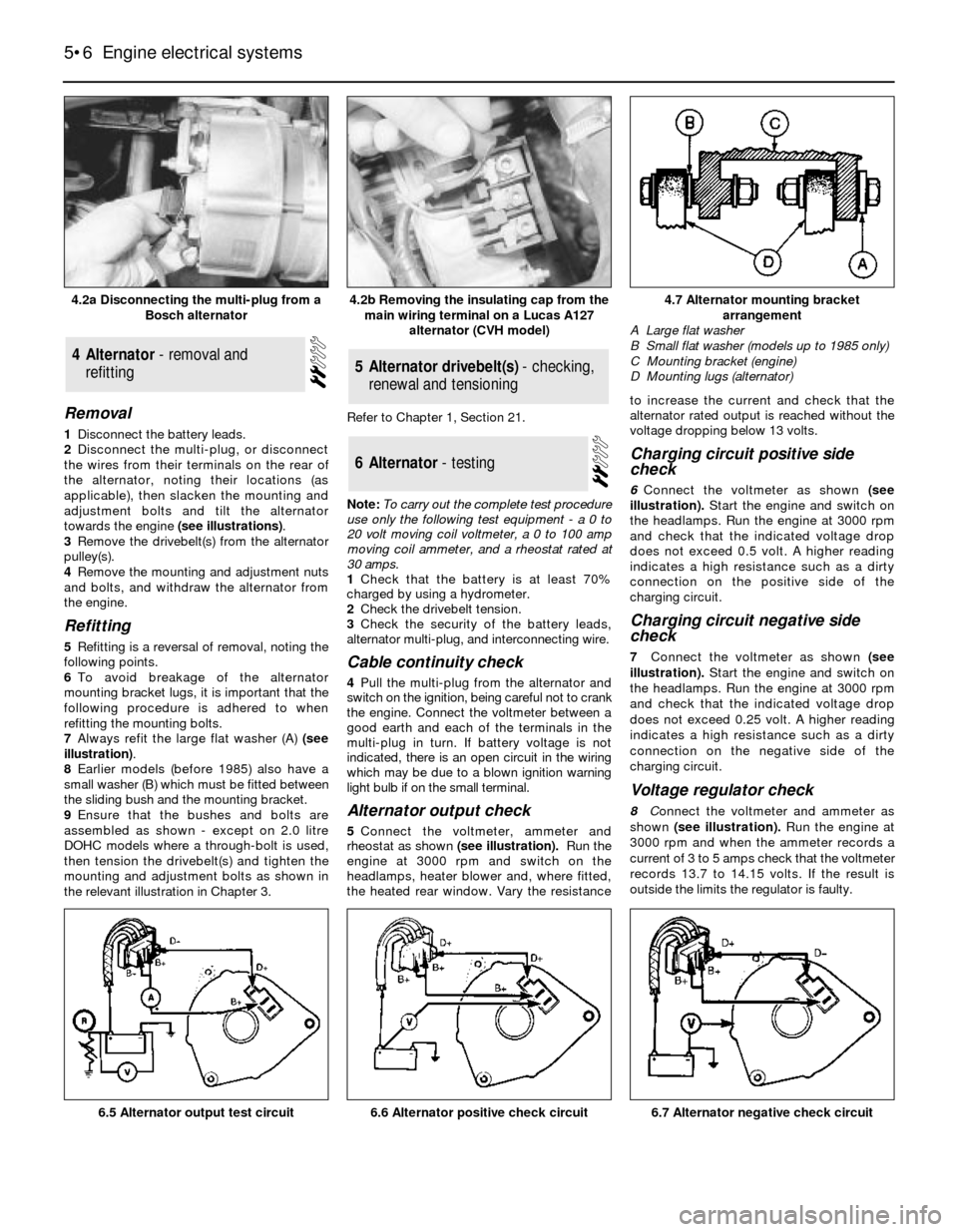run flat FORD SIERRA 1992 2.G Engine Electrical Systems Workshop Manual
[x] Cancel search | Manufacturer: FORD, Model Year: 1992, Model line: SIERRA, Model: FORD SIERRA 1992 2.GPages: 24, PDF Size: 0.93 MB
Page 6 of 24

Removal
1Disconnect the battery leads.
2Disconnect the multi-plug, or disconnect
the wires from their terminals on the rear of
the alternator, noting their locations (as
applicable), then slacken the mounting and
adjustment bolts and tilt the alternator
towards the engine (see illustrations).
3Remove the drivebelt(s) from the alternator
pulley(s).
4Remove the mounting and adjustment nuts
and bolts, and withdraw the alternator from
the engine.
Refitting
5Refitting is a reversal of removal, noting the
following points.
6To avoid breakage of the alternator
mounting bracket lugs, it is important that the
following procedure is adhered to when
refitting the mounting bolts.
7Always refit the large flat washer (A) (see
illustration).
8Earlier models (before 1985) also have a
small washer (B) which must be fitted between
the sliding bush and the mounting bracket.
9Ensure that the bushes and bolts are
assembled as shown - except on 2.0 litre
DOHC models where a through-bolt is used,
then tension the drivebelt(s) and tighten the
mounting and adjustment bolts as shown in
the relevant illustration in Chapter 3.Refer to Chapter 1, Section 21.
Note: To carry out the complete test procedure
use only the following test equipment - a 0 to
20 volt moving coil voltmeter, a 0 to 100 amp
moving coil ammeter, and a rheostat rated at
30 amps.
1Check that the battery is at least 70%
charged by using a hydrometer.
2Check the drivebelt tension.
3Check the security of the battery leads,
alternator multi-plug, and interconnecting wire.
Cable continuity check
4Pull the multi-plug from the alternator and
switch on the ignition, being careful not to crank
the engine. Connect the voltmeter between a
good earth and each of the terminals in the
multi-plug in turn. If battery voltage is not
indicated, there is an open circuit in the wiring
which may be due to a blown ignition warning
light bulb if on the small terminal.
Alternator output check
5Connect the voltmeter, ammeter and
rheostat as shown (see illustration).Run the
engine at 3000 rpm and switch on the
headlamps, heater blower and, where fitted,
the heated rear window. Vary the resistanceto increase the current and check that the
alternator rated output is reached without the
voltage dropping below 13 volts.
Charging circuit positive side
check
6Connect the voltmeter as shown (see
illustration).Start the engine and switch on
the headlamps. Run the engine at 3000 rpm
and check that the indicated voltage drop
does not exceed 0.5 volt. A higher reading
indicates a high resistance such as a dirty
connection on the positive side of the
charging circuit.
Charging circuit negative side
check
7Connect the voltmeter as shown (see
illustration).Start the engine and switch on
the headlamps. Run the engine at 3000 rpm
and check that the indicated voltage drop
does not exceed 0.25 volt. A higher reading
indicates a high resistance such as a dirty
connection on the negative side of the
charging circuit.
Voltage regulator check
8Connect the voltmeter and ammeter as
shown(see illustration).Run the engine at
3000 rpm and when the ammeter records a
current of 3 to 5 amps check that the voltmeter
records 13.7 to 14.15 volts. If the result is
outside the limits the regulator is faulty.
6Alternator - testing
5Alternator drivebelt(s) - checking,
renewal and tensioning4Alternator - removal and
refitting
5•6Engine electrical systems
4.2a Disconnecting the multi-plug from a
Bosch alternator4.7 Alternator mounting bracket
arrangement
A Large flat washer
B Small flat washer (models up to 1985 only)
C Mounting bracket (engine)
D Mounting lugs (alternator)
6.7 Alternator negative check circuit6.6 Alternator positive check circuit6.5 Alternator output test circuit
4.2b Removing the insulating cap from the
main wiring terminal on a Lucas A127
alternator (CVH model)